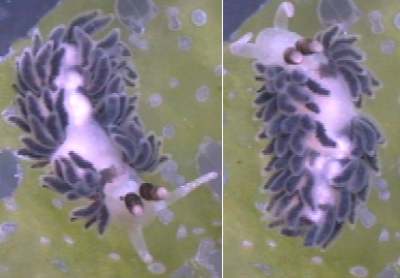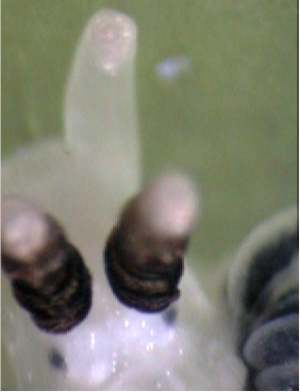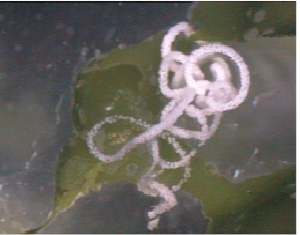

Favorinus ghanensis
Edmunds, 1968
Order: NUDIBRANCHIA
Suborder: AEOLIDINA
Family: Glaucidae
DISTRIBUTION
Know only from Ghana. Reported here from Tunisia.
PHOTO
Lac de Tunis" [southern part], Tunis, Tunisia, North Africa. Depth: 0 to 1m. January - March, 2003. Among Ulva rigida. Photo: Jamila Ben Souissi? Anis?
Favorinus ghanensis was desribed as being translucent greyish white with a few white dots on the head oral tentacles, back and tail. The rhinophores have three swellings and the tip is translucent clear with white dots, the rest being purple-brown or maroon. The general appearance of the digestive gland duct in the cerata is purple-brown. Edmunds considers the species differs from all others in the genus by the presence of a penial stylet and from F. branchialis in other features of the reproductive system.
Edmunds (1974) notes that he has seen more than 250 specimens amongst fouling organisms on the bottom of small fishing boats. He considers that this species is consistently different externally, to both the eastern Atlantic Favorinus branchialis and the western Atlantic F. auritulus. He notes that the main fouling organism was the bryozoan Zoobotryon verticillatum, and he observed Favorinus eating the zooids on a number of occasions. Two species of the bryozoan genus Bugula were sometimes present, but Edmunds saw no sign of them being eaten by F. ghanensis.
The eastern Atlantic species, F. branchialis is usually described as having only one rhinophoral swelling, near the tip, but Ortea (1982), in a review of the species of Favorinus from the Atlantic, reports that specimens from northern Spain sometimes have three swellings. He also says that F. branchialis feeds on the bryozoans, Bugula fulva and Bugula fastigiata when eggs are scarce during winter. When feeding on Bugula the colour of the digestive gland in the cerata is 'violet brown'. I am not sure how to interpret this information. Perhaps bryozoan feeding is more widespread in the genus than we realise, or perhaps its means that F. ghanensis also occurs in northern Spain.
References:
• Edmunds, M. (1968) Opisthobranchiate Mollusca from Ghana. Proceedings of the Malacological Society of London, 38: 83-100.
• Edmunds, M. (1975) An eolid nudibranch feeding on Bryozoa. The Veliger, 17(3):, 269-270.
• Ortea, J.A. (1982) A new Favorinus (Nudibranchia: Aeolidoidea) from the Canary Islands. The Nautilus, 96(2): 45-48.
Rudman, W.B., 2003 (May 5) Favorinus ghanensis Edmunds, 1968. [In] Sea Slug Forum. Australian Museum, Sydney. Available from http://www.seaslugforum.net/find/favoghan
Related messages
Favorinus ghanensis from Tunisia
May 8, 2003
From: Jamila Ben Souissi

Dear Bill,
Here is another sea slug to add to the collection already sent by my student Anis. It is also from the coastal lagoon, "Lac de Tunis" [southern part] in Tunis, Tunisia, North Africa. Depth: 0 to 1m, some time between January and March, 2003. It was found among the green alga Ulva rigida.
Cordially yours
Jamila Ben Souissi
Biologist
Institut National Agronomique de Tunisie, Tunis
bensouissi.jamila@inat.agrinet.tn


Dear Jamila,
This aeolid is almost certainly Favorinus ghanensis. Species of Favorinus usually feed on the eggs of other sea slugs, and the colour of their cerata - or rather the digestive gland duct inside it - usually takes the colour of the eggs they have been feeding on, but this doesn't seem to be the case here.
Your animal fits the description of F. ghanensis very well, including the blackish smudge on the body, alongside the anterior right ceratal arch. F. ghanensis is charaterised by the white-tipped black rhinophores, the 3 rhinophoral swellings and the penial stylet. Edmunds (1974) notes that he has seen more than 250 specimens amongst fouling organisms on the bottom of small fishing boats. He considers that this species is consistently different externally, to both the eastern Atlantic Favorinus branchialis and the western Atlantic F. auritulus. Edmunds (1974) notes that the main fouling organism was the bryozoan Zoobotryon verticillatum, and he observed Favorinus eating the zooids on a number of occasions. He also noted that two species of the bryozoan Bugula were sometimes present but saw no sign of them being eaten by F. ghanensis.
The eastern Atlantic species, F. branchialis is usually described as having only one rhinophoral swelling, near the tip, but Ortea (1982), in a review of the species of Favorinus from the Atlantic, reports that specimens from northern Spain sometimes have three swellings. He also says that F. branchialis feeds on the bryozoans, Bugula fulva and Bugula fastigiata when eggs are scarce during winter. When feeding on Bugula the colour of the digestive gland in the cerata is 'violet brown'. I am not sure how to interpret that information. Perhaps bryozoan feeding is more widespread in the genus than we realise, or perhaps its means that F. ghanensis also occurs in northern Spain.
This is a very interesting find. If my identification is confirmed, this is surely a new record from the Mediterranean, and the first record of the species outside of Ghana.
• Edmunds, M. (1968) Opisthobranchiate Mollusca from Ghana. Proceedings of the Malacological Society of London, 38: 83-100.
• Edmunds, M. (1975) An eolid nudibranch feeding on Bryozoa. The Veliger, 17(3):, 269-270.
• Ortea, J.A. (1982) A new Favorinus (Nudibranchia: Aeolidoidea) from the Canary Islands. The Nautilus, 96(2): 45-48.
Best wishes,
Bill Rudman
